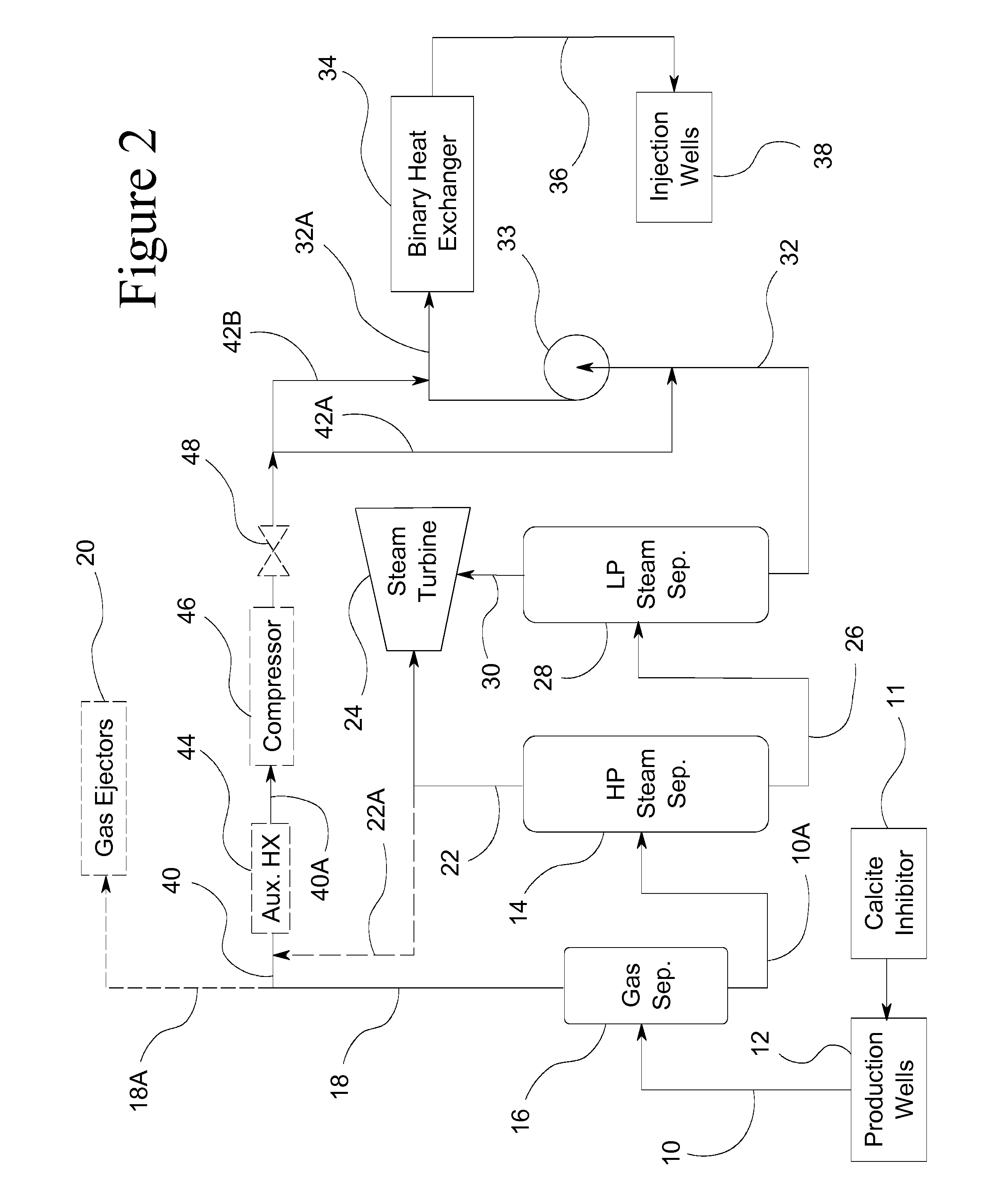Return carbon dioxide to flashed geothermal brine to control scale deposition in a geothermal power plant
a geothermal power plant and carbon dioxide technology, applied in the direction of machines/engines, mechanical equipment, separation processes, etc., can solve the problems of high heat transfer performance of the binary heat exchanger, damage to the reinjection well, and degrade the heat transfer performance, so as to reduce the ph of the brine and reduce the supersaturation of ph sensitive minerals
- Summary
- Abstract
- Description
- Claims
- Application Information
AI Technical Summary
Benefits of technology
Problems solved by technology
Method used
Image
Examples
case 1
P(HX) and X(CO2,40) is large
[0062]In this case, compressor 46 is not needed, and gas-rich vapor 40 is preferably combined with flashed brine 32 downstream of pump 33; that is, following path 42B. If X(CO2,40) is fairly large (for example, above 10 mole-%), the amount of water vapor in gas-rich vapor 40 will be modest, and auxiliary heat exchanger 44 would be of little benefit. Alternatively, if X(CO2,40) is large and pump 32 has sufficient suction head, gas-rich vapor 40 can be combined with brine 32 upstream of pump 33 following path 42A. Pump suction must be considered in this case, because the water vapor added to brine 32 with gas-rich vapor 40 will increase the temperature and vapor pressure of the brine, possibly causing cavitation and reducing the efficiency of pump 33 if suction head is insufficient.
case 2
P(HX) and X(CO2,40 or 22A) is small
[0063]In this case path 42B can be used, and auxiliary heat exchanger 44 can optionally be used to condense most of the water vapor in gas-rich vapor 40 or high pressure steam 22A. Gas-rich vapor 40 or high pressure steam 22A can also be combined with brine 32 upstream of pump 33 following path 42A; in this case auxiliary heat exchanger 46 should be used to prevent boiling and cavitation at the suction of pump 33.
case 3
P(HX) and X(CO2,40) is large
[0064]In this case gas-rich vapor 40 can be combined with brine 32 upstream of pump 33 following path 42A if sufficient suction head is available. Optionally, gas-rich vapor 40 can be combined with brine 32 downstream of pump 33 following path 42B if compressor 46 is used. Auxiliary heat exchanger 44 is desirable in this case to minimize the amount of water vapor that enters compressor 46.
PUM
| Property | Measurement | Unit |
|---|---|---|
| weight percent | aaaaa | aaaaa |
| temperature | aaaaa | aaaaa |
| alkalinity | aaaaa | aaaaa |
Abstract
Description
Claims
Application Information
 Login to View More
Login to View More - R&D
- Intellectual Property
- Life Sciences
- Materials
- Tech Scout
- Unparalleled Data Quality
- Higher Quality Content
- 60% Fewer Hallucinations
Browse by: Latest US Patents, China's latest patents, Technical Efficacy Thesaurus, Application Domain, Technology Topic, Popular Technical Reports.
© 2025 PatSnap. All rights reserved.Legal|Privacy policy|Modern Slavery Act Transparency Statement|Sitemap|About US| Contact US: help@patsnap.com



